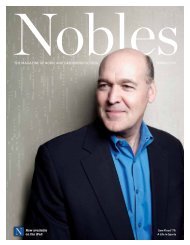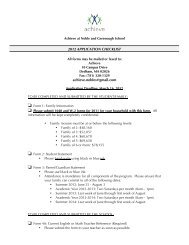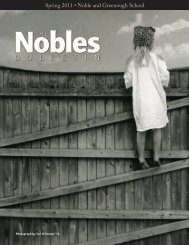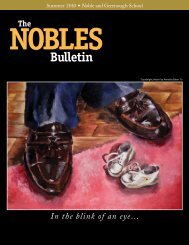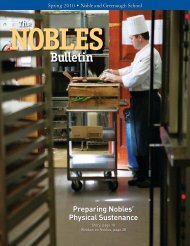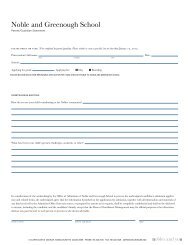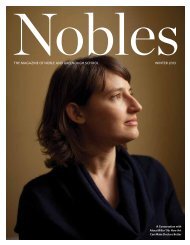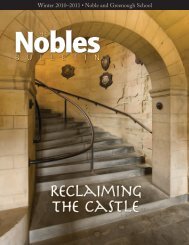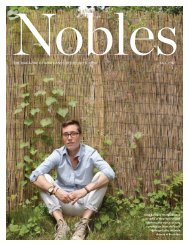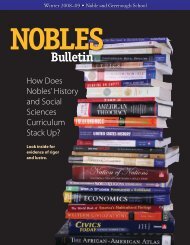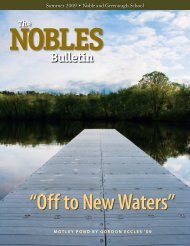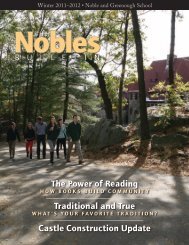B u l l e t i n - Noble and Greenough School
B u l l e t i n - Noble and Greenough School
B u l l e t i n - Noble and Greenough School
Create successful ePaper yourself
Turn your PDF publications into a flip-book with our unique Google optimized e-Paper software.
one Saturday in october, after hitching into accra to do<br />
some shopping, I ran into black intellectual Sinclair Drake.<br />
Drake was a member of our training faculty at Berkeley who<br />
had befriended many of africa’s new heads of state in the<br />
1950s, including the osagyefo, Dr. Kwame nkrumah, first<br />
president of Ghana. “Come on, Flather”—he always called me<br />
Flather—“we’re going to the airport to welcome the osagyefo.<br />
He is returning from China. It will be a spectacle, <strong>and</strong> you<br />
should see it.” I was not disappointed. a crowd of as many as<br />
100,000 had gathered on the airport apron, with dozens of<br />
paramount chiefs <strong>and</strong> sub-chiefs under their ceremonial umbrellas<br />
<strong>and</strong> with their entourages, all in full regalia, dressed in<br />
resplendent kente cloths <strong>and</strong> gold ornamentation, all with<br />
drummers <strong>and</strong> traditional horns <strong>and</strong> bells. “This no be small<br />
small,” Drake said to me, speaking in West african pidgin.<br />
Then, as the crowd began to move to make room for the president,<br />
Drake <strong>and</strong> I were pressed into the second row. as nkrumah<br />
moved along, he seemed startled as he came upon the<br />
diminutive Drake <strong>and</strong> oversized me. “Drake, what are you doing<br />
here?” Drake replied, “Hello, Kwame. I have just delivered<br />
your Peace Corps, <strong>and</strong> now you can meet one of them.” So<br />
there I was, hardly out of college, in the country for just over a<br />
month, surrounded by thous<strong>and</strong>s of Ghanaians, shaking h<strong>and</strong>s<br />
with the president. I would see him again at the end of our<br />
tour, when he feted us at a farewell gathering at Flagstaff<br />
House, his residence—a fitting bookend for our two-year experience,<br />
which had begun with President Kennedy in the<br />
rose Garden.<br />
a few weeks later, back in accra, I took in a movie before<br />
returning to Winneba. From Here to Eternity was playing at<br />
the orion, adjacent to the lorry park where I would catch my<br />
ride. an emotional high point in the film occurs when<br />
Montgomery Clift plays taps after Ernest Borgnine has<br />
beaten Frank Sinatra to death. Sitting by myself during that<br />
scene in the darkened theatre, I suddenly felt a tapping on<br />
my shoulder. as I turned to see three men sitting behind me,<br />
one leaned forward saying, “Sorry...sorry, sorry.” an anonymous<br />
someone was showing compassion to a young white<br />
american stranger. not long afterward, while away teaching,<br />
I was visited by a “tief man,” as robbers are called. Thoughtful<br />
individual that he was, he lifted half of everything, one pair<br />
of shoes, one pair of slacks, some socks <strong>and</strong> a radio; he carefully<br />
left half of my possessions for me. I realize now that I<br />
was beginning to feel at home in Ghana.<br />
There are so many more stories to tell, but only time just<br />
to mention three great friendships formed in Ghana 50 years<br />
ago. These friends are a Ghanaian man, a Williams grad now<br />
tenured at Brown; a Ghanaian woman, my best student, who<br />
just stepped down as Ghana’s leading public health researcher<br />
(as a non-science person, I like to boast that I did no<br />
harm); <strong>and</strong> a brilliant colleague at Winneba, an african<br />
american, who is retired as director of writing at lincoln-<br />
Sudbury High <strong>School</strong>. These three friendships have matured<br />
<strong>and</strong> themselves inspired many, many more stories—but these<br />
tales will have to wait for another time <strong>and</strong> after further reflection<br />
on a life decision taken in 1961. —nEWEll FlaTHEr<br />
The photo of Newell Flather ’56 in Ghana (above, opposite) ran<br />
in the Winter 2011–12 issue of the Bulletin. The then-unidentified<br />
man in the center was identified as Flather by scores of graduates<br />
<strong>and</strong> friends or, as Flather puts it, his “fan base.”<br />
out oF CoNtext No one could identify every person pictured in this<br />
1942 photo, which ran in the previous issue of the Bulletin. Graduates’<br />
collective knowledge, however, gives us the following tentative<br />
iDs. Front row: Dick Flood Jr. ’53; second row: Charles s. bird iii, Dick<br />
Flood ’23, ellen Flood, bill harding ‘42; third row: Arnold Garrison ‘42,<br />
howard Ch<strong>and</strong>ler ‘43 <strong>and</strong> Dick bingham ’43. back row: Neil Ayer ’43,<br />
Jim shattuck ’44, Peter Walker ’44 <strong>and</strong> James M. Martinez ’39.<br />
the <strong>Noble</strong>s bulletiN spring 2012 63



